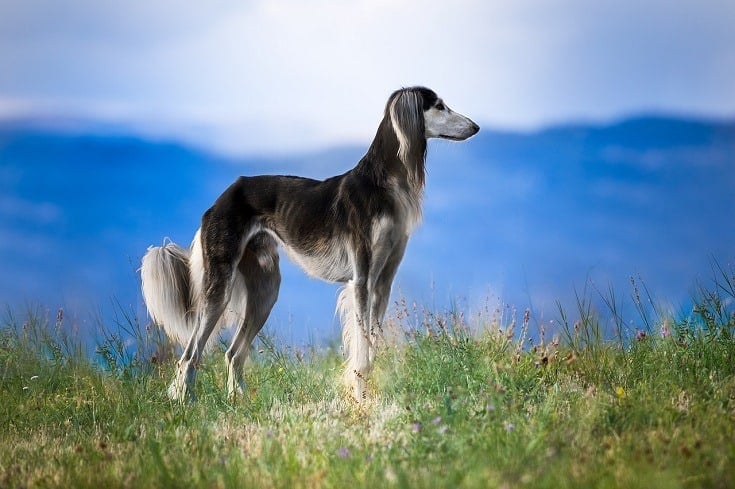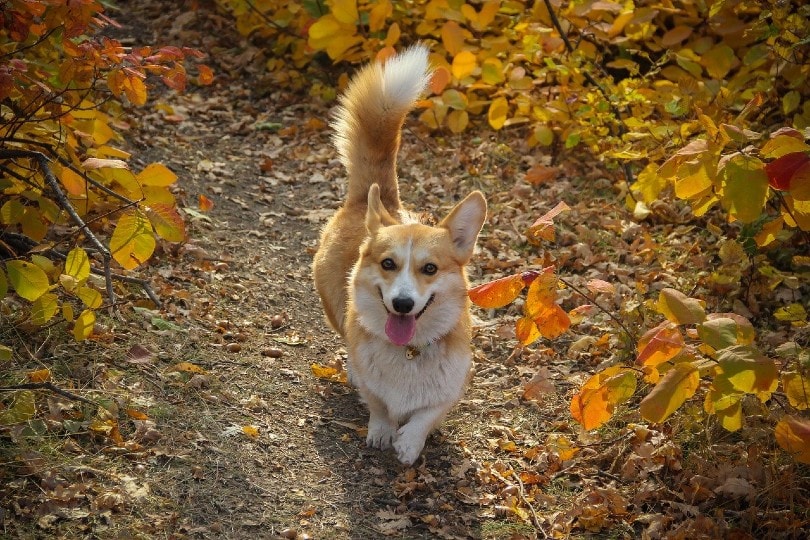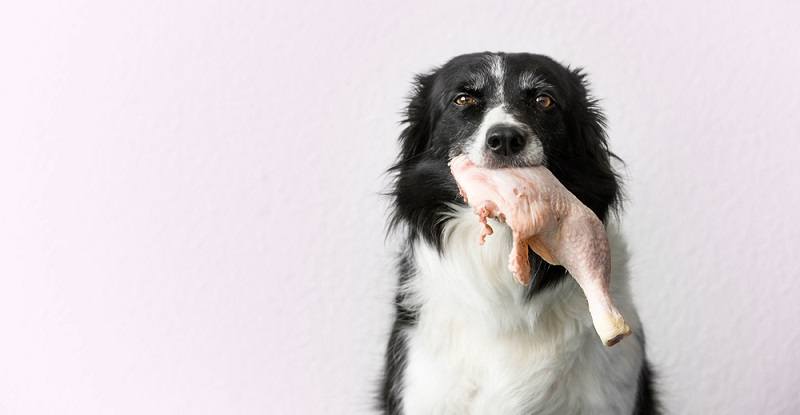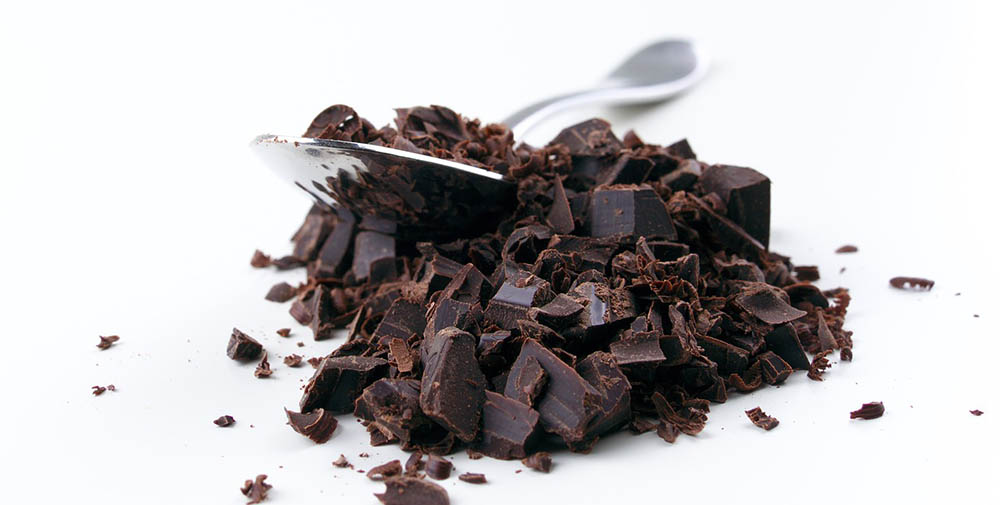Height:
11-12 inches
Weight:
16-28 pounds
Lifespan:
10-14 years
Colors:
Blue, white
Suitable for:
Apartment living, companionship
Temperament:
Easy-going, loving, cuddly
The Blue French Bulldog is a color variation of the commonly known French Bulldog or Frenchie. They are an adorable dog bred to be an excellent companion and a highly adaptable house pet or apartment-dweller since they are so small.
The Blue French Bulldog is primarily the same dog as any other Frenchie color variety. They are stocky but small with loose skin and a somewhat brachycephalic face with large ears. The characteristic that sets them apart is their rare coat of smooth bluish-gray. There are solid varieties as well as those that have patterns with some white on them.
 Blue French Bulldog Puppies – Before You Buy…
Blue French Bulldog Puppies – Before You Buy…
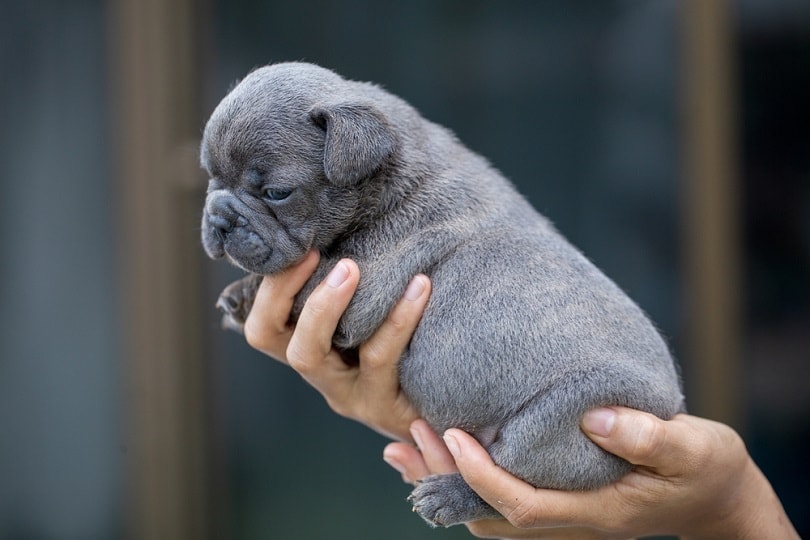
What’s the Price of Blue French Bulldog Puppies?
Since the blue coat is one of the rarer colors on a dog, Blue French Bulldogs sell for more than a typical Frenchie does. Although other color variations of a French Bulldog with a good pedigree cost between $1,500 to $3,000, Blue Frenchies cost about $1,000 more on average. Dogs of this breed that have outstanding pedigrees can cost up to $10,000, although this is not common.
Just like when you adopt any other kind of dog, it is always good to see if you can find the pup you want in a shelter before turning to a breeder. If you do go to a breeder for these pups, then it is essential to encourage positive breeding habits and check into the area in which they breed their dogs.
Ask to get a tour around the breeder’s facility. They should be willing to show you around any area in which they allow their dogs. This tour gives you the opportunity to check into their safety measures for the animals.
Before adopting your new Blue, it is also a good idea to ask to see the parents’ certification or registration papers. It can help to prove parentage and pedigree if that is a concern for you.
Lastly, take a look at or get a copy of the parents’ vet records. These will make you aware of any potential health concerns you should be aware of for your puppy. If there is anything that can be genetically inherited, it is best to let your vet know so they can watch out for it in the future.
 3 Little-Known Facts About Blue French Bulldogs
3 Little-Known Facts About Blue French Bulldogs
1. French Bulldogs are not from France.
French Bulldogs are one of the many breeds that come with a somewhat deceiving name. They do not come from France as their name would suggest. Instead, they were first bred around the area of Leeds in the United Kingdom.
The reason for their breeding was to create more of a companionable, less fearsome version of the English Bulldog. These ancestors are widely known for their original purpose of bull-baiting and then blood sport. They worked as a helper to cattle butchers later on but had lost their purpose for the most part.
To help save this breed, they began to cross other dogs with English Bulldogs to get a smaller dog. The result was the French Bulldog, although they weren’t known by this name at the time. Some of the other breeds they were crossed with include smaller Terriers that would reduce the Bulldog’s size.
In the end, these smaller Bulldogs didn’t suit the tastes of most Britians at the time. They grew in popularity in the sector of lacemakers but otherwise didn’t gain much popularity. When the lace workers began to move to France in search of better opportunities, they took their little dogs with them.
In France, they were welcomed with open arms. Their popularity skyrocketed, and France became known for these little dogs instead of their homeland.
France has long been considered a trendsetter in terms of fashion and social standards. With the growing popularity of the French Bulldog in France, they quickly became an integral part of vogue society. They became a fashionable companion dog to have by your side, and the interest in them spread throughout the remainder of Europe.
Due to this popularity, these dogs were among the early breeds to make their way to America. The first Frenchies came to the United States’ shores in the mid-1800s and were accepted as a companion breed by the AKC in 1898.
Frenches became a symbol of social status, frequently being owned by the most highbrow people. During the turn of the 20th century, these pups hit a peak in their fame. They were sold for as much as $3,000. In today’s money after inflation, that is the equivalent to $35,000.
Although they were not originally very popular in Britain, they are now set to top out above the Labrador as one of the most desirable dogs in the UK. In the United States, Frenchies have consistently been among the top six most popular dogs for the last decade. Their popularity has led to some illegal puppy mill activity, which makes checking out their breeder so important.
3. The blue coat color is caused by a recessive gene.
The Blue French Bulldog is primarily set apart because of the manifestation of a single gene in their DNA. The smooth blue-gray coat color is caused by a recessive gene known as the dilution gene.
In many dogs, this gene is not a preferable trait. Interestingly, even in the French Bulldog, colors that are accepted by the breed standard include only brindle, cream, fawn brindle, fawn, and white. Blue does not make the accepted list, partially due to its rarity and partly because of the health conditions known to come along with it.
It is also stunning that even though the breed standard doesn’t accept the color, these dogs are often twice as expensive.
This dilution gene is typically viewed as an undesirable trait. It is not so in the French Bulldog, but, unfortunately, this gene’s expression can also mean suffering from a genetic condition called color dilution alopecia.
This disease can end up causing patches of hair thinning or complete loss of hair in patches. It can generate areas of very flaky skin that causes itchiness. The condition is genetically inherited, meaning when a dog is bred to have a blue coat, they are also breeding this condition into them. That is why it is best not to select your pup for their coat color but for healthy breeding practices.
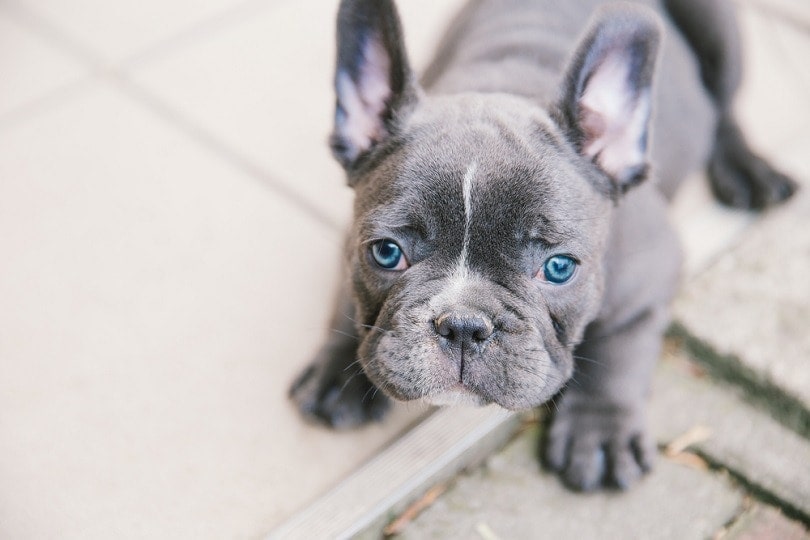
Temperament & Intelligence of the Blue French Bulldog
The French Bulldog is a breed meant for long-term companionship. They are a relatively low-energy breed. However, the time you don’t spend taking the dog out for exercise needs to be swapped for time spent interacting with them. They quickly begin to suffer from symptoms of separation anxiety if they are left alone for too long. It can end up resulting in some destructive behavior.
Frenchies are highly adaptable and can be very social and friendly dogs. This behavior does somewhat depend on the socialization they experienced when they were younger. It is best to introduce them to strangers or other animals with some consistency, so they maintain this behavior as they age.
Frenchies are often the most content when they can make you happy. They are not known for being the smartest dogs on the block but will try harder if you want them to.
Are These Dogs Good for Families?
These dogs do very well as a family dog. They are a small breed, so they are not very threatening nor do they pose potential harm to kids. They are gentle and generally extremely friendly. They enjoy being handled and loved, so having more people around is generally better for them.
Does This Breed Get Along with Other Pets?
The French Bulldog gets along with other breeds quite well, particularly if they were socialized well. If they have been introduced to other dogs and even cats at a younger age, they are likely to behave well around them as they age.
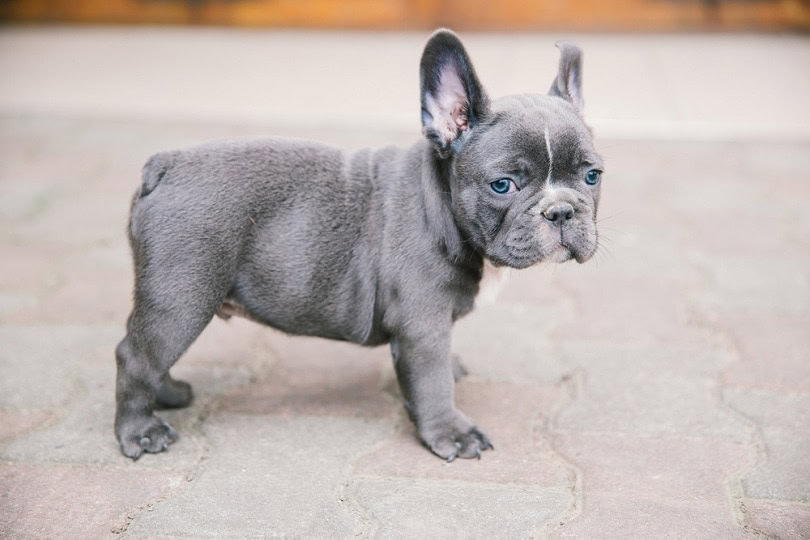
 Things to Know When Owning a Blue French Bulldog:
Things to Know When Owning a Blue French Bulldog:
Food & Diet Requirements
A French Bulldog is a small dog that doesn’t like to exercise very much. That means their appetite is generally pretty low, even if they seem like they are always hungry. They should only be given between 1-2 cups of food each day.
Feed them high-quality food, preferably one that has smaller kibble than average. The kibble size and shape can make it easier for them to eat since they tend to have smushed faces that make it more difficult for them to pick up the pieces and even chew them properly. Feed them twice a day to spread out their meals and prevent potential bloating issues.
Exercise
A Frenchie is a low-activity dog. They have a sort of jumpy energy level that will manifest in short bursts of excitement. They are never over-the-top and will typically need slower activities when they do exercise. Again, because of their brachycephalic faces, these little pups have difficulties breathing sometimes.
When you go outside to give them exercise, go for slower walks. Don’t engage them in bouts of intense exercise since they can quickly overexert themselves without meaning to do so. They only need about 30 minutes of activity each day. If you enjoy taking them out for walks, aim for about 6 miles each week.
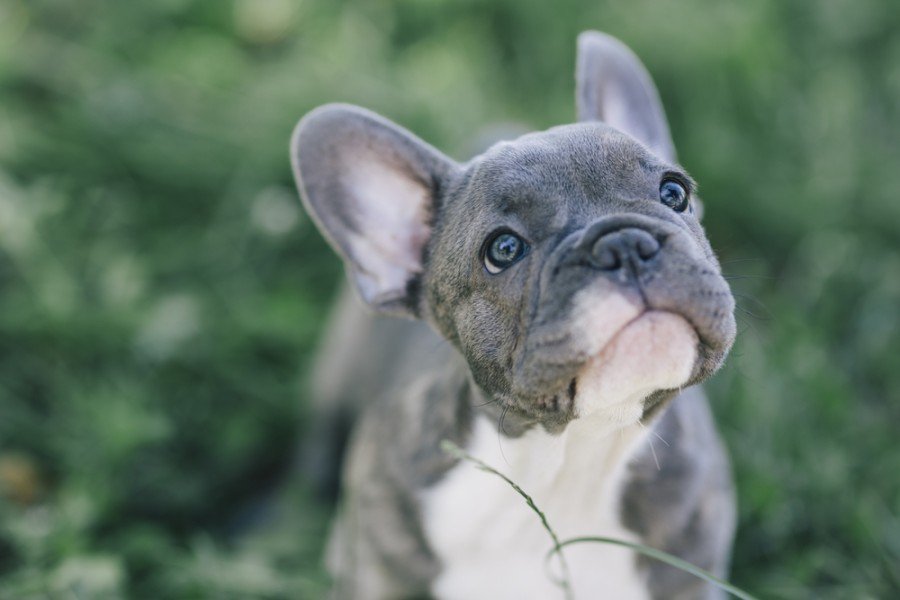
Training
Training your Blue French Bulldog can be an interesting process. They are intelligent but don’t stand out as a smart breed compared to other dogs. They enjoy learning some new things but can also be quite stubborn at times.
Figure out what motivates your Frenchie in order to find the most success with training them. You should train them in quite a few shorter sessions throughout the days and weeks to get it to stick in their minds. Don’t ever be harsh with them since all this will do is discourage them in future sessions.
Grooming ✂️
Grooming your Blue French Bulldog is an easy task that doesn’t typically take much time but serves as a great bonding experience. Their coat is short and close to the skin. They do not tend to shed very much and therefore only need minimal brushing, about once a week. Since this breed has an increased chance of skin dermatitis, you should avoid bathing them.
Keep an eye on the skin and hair of your Blue Frenchie since they can develop worse skin problems than a typical Frenchie will.
Beyond their fur, keep their teeth brushed since their brachycephalic faces can make them more prone to tooth and mouth diseases. They should have their nails clipped a couple of times a month and be carefully guarded against intense heat or cold.
Health and Conditions
As stated in previous sections, there are quite a few health issues that a French Bulldog is prone to, and even more that Blue Frenchies can experience. Keep a close eye on them as they get older and maintain their trips to the vet, perhaps more often than average.
- Cherry eye
- Distichiasis
- Cataracts
- Pulmonic stenosis
- Retinal dysplasia
- Atopic dermatitis
- Hypothyroidism
- Spine malformations such as hemivertebrae
- Color dilution alopecia
- Allergies
- Skin allergies
- Brachycephalic syndrome
- Respiratory issues
- Intervertebral disc degeneration
- Hip dysplasia
- Skinfold dermatitis
- Ear infections
 Male vs. Female
Male vs. Female
There are no distinguishable differences between male Blue French Bulldogs and female Blue French Bulldogs.
 Final Thoughts
Final Thoughts
Although adopting such a beautiful pup with a rare coat color can be alluring, it is also worth considering what encouraging these breeding traits means for the dog’s future. It might be best to seriously consider another color of Frenchie if you are interested in adopting one of these extremely lovable little dogs. There are many reasons that they have been so popular for so long, but their good health is not one of them. All in all, Frenchies of any color do make excellent companion pups for families, singles, and seniors.
Featured Image Credit: Firn, Shutterstock

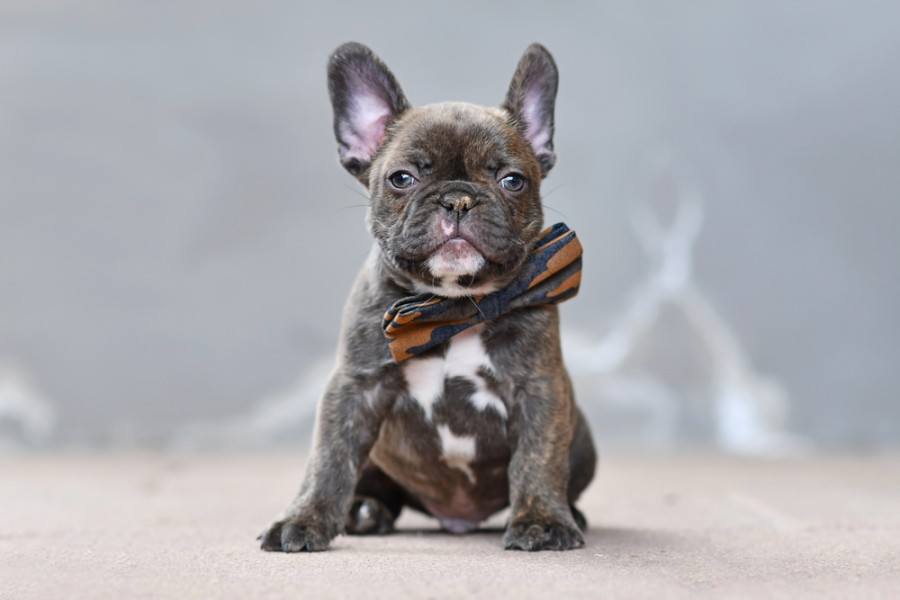
 Blue French Bulldog Puppies – Before You Buy…
Blue French Bulldog Puppies – Before You Buy… 3 Little-Known Facts About Blue French Bulldogs
3 Little-Known Facts About Blue French Bulldogs
 Things to Know When Owning a Blue French Bulldog:
Things to Know When Owning a Blue French Bulldog: Final Thoughts
Final Thoughts